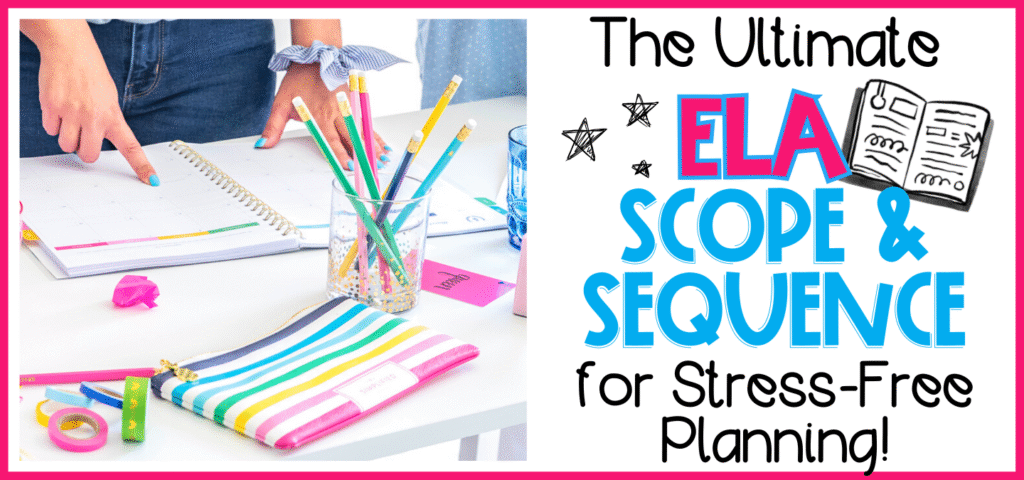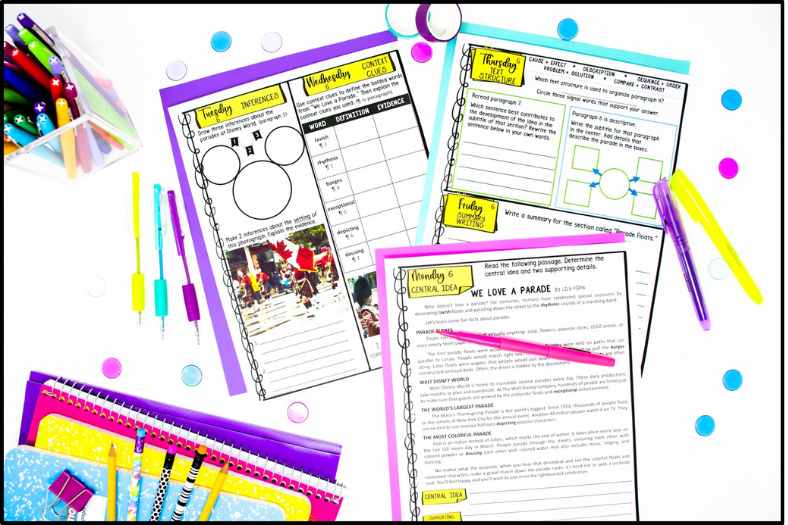A scope and sequence is a detailed framework that outlines what will be taught (the scope) and the order in which it will be taught (the sequence). An ELA scope and sequence serves as a helpful pacing guide for planning the topics, standards, and projects to cover during a school year.

If planning lessons for your 6th and 7th grade ELA classes is like assembling IKEA furniture with missing instructions, you’re not alone. This ELA scope and sequence example is your shortcut to a smoother teaching year. It’s designed for 6th and 7th-grade English Language Arts but even works with some 8th grade classes.
Pacing guides should be flexible, friendly, and easy to tweak as you go. They should be sequenced so that the skills progress logicall and build off one another.
This guide is packed with strategies and resources for reading, writing, grammar, and more—all designed to be a framework to hit standards and save your sanity.
Before I show you the best ELA scope and sequence I’ve used, I’ll explain how I organized it and how I approach each subject area.
If you’d like, you can scroll down for the entire pacing guide, semester by semester.
Reading
I usually teach one or two whole-class novels per year, but the timing varies, so they aren’t on a set schedule in this pacing guide. I also supplement with grade-level short stories and timely news articles.
Every 4-5 weeks, students choose their own books and use Independent Reading Journals. My students read more when I give them agency to choose their own reading material. Parents love this too and regularly report their joy over seeing their kids reading at home.
I vary the genres. Sometimes I give them a broad requirement, such as “free-choice fiction,” and sometimes it’s narrow, such as “science fiction” or “memoir.”
Writing
Our classrooms are a beautiful, chaotic mix of student abilities. You probably have kids who could write a novel tomorrow sitting next to kids who look at a blank page like it’s a personal insult. It’s our job to meet them all where they are.
My resources are packed with a lot of scaffolding to support this range. But sometimes, even that isn’t quite enough. For my students who need an extra boost, I created sets of writing frames. While I don’t use them with every class, they have been a total game-changer for my remedial classes and small groups.
These frames give struggling writers the structure they need to get their ideas down without staring into the void. The result? They start building real skills, and more importantly, they gain the confidence to see themselves as writers.
Bell Ringers / Warm-Ups

Spiral Review Bell Ringers are a staple in my classroom. Almost every Monday starts with a 5-10 minute, high-interest reading passage, featuring every genre from adventure to poetry, so students never know what they’ll get next. On Tuesdays through Thursdays, students practice a specific skill based on that passage. Friday is dedicated to writing about the passage. The writing prompts might include summarizing, creative fiction, a text-based response, or an argument-based piece.
My class periods are only 43 minutes long, so some weeks are just too packed to fit in the bell ringers. In those weeks, I save the extra bell ringer sets to assign as homework. They also make fantastic sub plans. A full Monday-Friday unit takes about 40-50 minutes total, which is perfect for a class period. It’s a structured, meaningful activity you can leave for a substitute without any stress.
Holiday Activities
Trying to teach a serious lesson the day before a holiday break is like trying to herd cats in a room full of laser pointers. It’s not happening.
Those days are perfect for whipping out the holiday resources. Kids have days when their focus is just gone, and instead of fighting it, we can use the holiday excitement to our advantage. These activities are fantastic for practicing soft skills like communication, problem solving, and team-building without feeling like another lesson.
Big kids get just as excited about celebrations as little kids do, but we rarely give them the chance to let off some steam and enjoy the moment. These activities give kids that space.
Because every school’s calendar is different, I haven’t included most of them in the scope and sequence. I’ve only placed the December holidays in the pacing guide as an example. You should use the holiday resources whenever they fit best for you and your students.
Supplemental Activities
Every teacher should have extra resources that aren’t scheduled for a specific time on the calendar. They become your classroom utility players, ready to jump in whenever you need them. Think of them as your secret weapon for enrichment, brain breaks, early finishers, and those weird half-days before a long weekend.
I use goodies like the podcast listening resources with mystery pictures and fun writing activities. They’re perfect for a Fun Friday reward or a last-minute substitute lesson that doesn’t feel like busywork.
My other MVPs are fun, print-and-go escape rooms that require critical thinking skills and problem-solving.
Each semester includes the resources I use. You can teach the same skills by substituting other learning materials.
ELA Scope and Sequence for Grades 6-7
Semester 1
| RESOURCES | CONNECTIONS & RATIONALE |
| Bell Ringers / Spiral Review Volume 1 | Entire semester: 1 unit per week |
| Fiction Independent Reading Journal | Entire Semester: 2 per semester |
| Back to School Stations | Day 1 of School |
| Back to School One Pager/Name Tent | Day 2 of School |
| Close Reading: Teach, Practice, Test | Includes fiction and nonfiction. Teaches students what to look for when reading and how to annotate text. |
| RACES Writing Paragraph Frames | RACES is used all year to respond to literature. |
| Plot & Conflict: Teach, Practice, Test | Discussions about literature hinge on knowledge of plot and conflict, as does narrative writing. |
| Theme: Teach, Practice, Test | Covered prior to our first big writing workshop unit: Narrative Writing. We begin with personal and/or biographical narratives. |
| Narrative Writing Guided Notes | All slides and notes: personal, fictional, and biographical. |
| Writing Workshop Mini Lessons | Pull specific lessons out as needed. |
| Context Clues: Teach, Practice, Test | These skills will be used all year. |
Semester 2
| RESOURCES | CONNECTIONS & RATIONALE |
| Bell Ringer Spiral Review Volume 2 | Entire semester: 1 unit per week |
| Fiction Independent Reading Journal | Entire semester: 2 per semester |
| Characterization: Teach, Practice, Test | Covered prior to our fiction writing unit: Narrative Writing |
| Character Types: Teach, Practice, Test | Covered before our fiction writing unit: Narrative Writing |
| Text Evidence Writing | Expands on RACES Writing Unit |
| Setting, Mood, Tone: Teach, Practice, Test | Works concurrently with our Narrative Writing unit as we turn our attention to fictional story writing and practice creating mood. |
| Point of View: Teach, Practice, Test | Works concurrently with Narrative Writing. (I will often have students try to switch the narrative viewpoint, which often ends up being better than the original!) |
| Narrative Workshop (fiction) | Review the fiction writing notes and then use the workshop pages on writing fiction. |
| Writing Workshop Mini Lessons | As needed |
| Holiday Activities: Holiday One-Pager Holidays Around the World Reading Escape Room and/or Christmas Escape Room New Year Reading Comprehension Escape Room New Year One-Pager | Use if the holidays are during this semester. The holiday season brings many interruptions and distractions. Those challenging days are perfect for the supplemental activities. Note: If the holiday is not during your 2nd semester, this would be a great time to work on listening skills: Podcasts. |
Semester 3
| RESOURCES | CONNECTIONS & RATIONALE |
| Bell Ringer Spiral Review Volume 3 | Entire semester: 1 unit per week |
| Nonfiction Independent Reading Journal | 4-5 weeks |
| Fiction Independent Reading Journal | Following 4-5 weeks |
| Author’s Purpose and POV: Teach, Practice, Test ——————————— Summarizing and Paraphrasing: Teach, Practice, Test | Skills correspond with our next 3 writing units: Informative Writing, Argument Writing, and Feature Article Writing. |
| Informational Writing Guided Notes | Teach prior to the informational writing unit. |
| Informational Writing Workshop | If there are time limitations, encourage students to write about a topic they are very familiar with. |
| Central Idea: Teach, Practice, Test | Helpful before argumentative writing. |
| Argument Writing Guided Notes | Teach prior to the argumentative writing unit. |
| Argument Writing Workshop | Allow time for this, as the mentor texts and research can be challenging for students. |
| Argument Writing Paragraph Frames | Use the frames with struggling writers or writers who are brand new to argument writing. |
Semester 4
| RESOURCES | CONNECTIONS & RATIONALE |
| Bell Ringer Spiral Review Volume 4: Heroes Theme | Entire semester: 1 unit per week |
| Nonfiction Independent Reading Journal | 4-5 weeks |
| Fiction Independent Reading Journal | Following 4-5 weeks |
| Figurative Language: Teach, Practice, Test | Preparing for poetry, memoirs, and feature article units. |
| Poetry Close Reading: Teach, Practice, Test | Teach prior to writing poetry. |
| Poetry Writing Stations | Teach before writing poetry. |
| Memoir Writing | Start with these writing frames and then move on to blackout poetry or another poetry genre. |
| Text Structures: Teach, Practice, Test | Helpful preparation for feature article writing. |
| Feature Article Writing Workshop (You should be teaching this.) | This unit is the culmination of our reading and writing units, as a feature article can include narrative, informative, and argument writing, as well as figurative language. |
Middle School ELA Scope and Sequence
How do I teach grammar and vocabulary?
Instead of teaching isolated rules that make students’ eyes glaze over, I integrate grammar directly into our reading and writing. This way, they can see how grammar actually controls meaning, which is a lot more useful than just circling nouns on a worksheet. The most focused grammar instruction can be found in the Writing Workshop Mini-Lessons unit.
When it comes to vocabulary, we utilize content-area word walls, notes, and plenty of context clue practice. In the past, I’ve wrestled with Greek and Latin roots units and found that getting the learning to stick was a real challenge. This approach feels much more effective for building a vocabulary that students can actually use.
Why wait until the end of the year for figurative language and text structure?
In a perfect world with a weird time warp vibe, I’d be able to teach every in-depth unit we cover at the beginning and review like crazy all year. Unfortunately, that’s not possible. I introduce students to concepts as they come along, and I make sure those opportunities happen frequently! Then I teach the more comprehensive units when they make sense and there is time.
Do I have to use these resources?
Not at all. You can use the the topics as a pacing guide and substitute any resources you’d like.
Creating a Scope and Sequence
This is the scope and sequence that works for me.
Do I get to everything? No way.
Do I make changes? Frequently.
Feel free to use mine as a model to create your own curriculum pacing guide. Remember to organize it in a way that fosters students’ learning and skill mastery. And when you’re reviewing a curriculum’s sequence, ask yourself two questions:
- Does it flow logically?
- Do the skills build on each other in a meaningful way?
Drop your questions in the comments. I’ll be happy to help!





